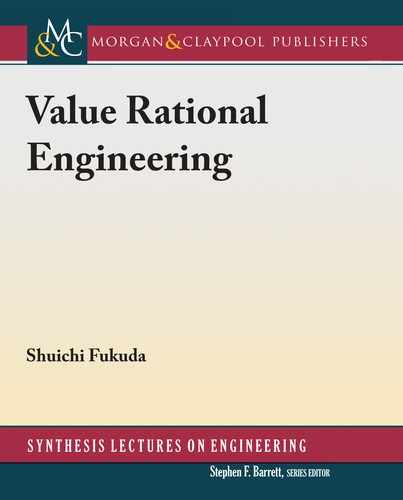
4 1. BIG SHIFT IN ENGINEERING
Yesterday
Smooth Change
Differentiable
Predictable
Figure 1.2: Changes of yesterday.
Today
Sharp Change
Not Differentiable
Not Predictable
Figure 1.3: Changes of today.
sharp, so we cannot differentiate them mathematically. erefore, we cannot predict the future
anymore (Fig. 1.3).
1.3 BOUNDED RATIONALITY AND SATISFICING
Herbert A. Simon pointed out that rationality is bounded [1] and, outside of the bounds of
rationality, we cannot optimize the result. We have no other choice than to solve the problem
in a way just to get the satisfying results. Simon called this Satisficing (Satisfy C Suffice) [2].

1.4. RATIONAL WORLD TO CONTROLLABLE WORLD 5
1.4 RATIONAL WORLD TO CONTROLLABLE WORLD
SYSTEM IDENTIFICATION
When the world was small and closed, we could apply mathematical rationality in a straightfor-
ward manner. But as our world of engineering is quickly expanding with the expansion of our
world, the problem came up that we cannot apply mathematical rationality in a straightforward
manner as we could until then.
e word “straightforward” is used. But we should pay attention to the efforts of engineers
to develop such rational approaches. Even in a small closed world, systems have large degrees of
freedom. So, if we look at the system and try to solve the problem simply in a straightforward
manner, the problem of computational complexity comes up and we cannot solve it. erefore,
engineers classified systems into clusters and if they find out the system belongs to the same
cluster, then they can apply the model, whose degrees of freedom are reduced to the minimum,
to solve the problem. is is called System Identification and it is nothing other than identifying
this model. en, they know what parameters they should take care of because each model has
a specific set of parameters. us, they could solve the problems in a “straightforward” manner.
EXPANDING THE RATIONAL WORLD
But the world is expanding very quickly, and it becomes increasingly difficult to solve the problem
this way, i.e., mathematically and get the result quantitatively. Traditional engineering required
mathematical rationality and optimized results. is is, in a sense, a challenge to the bounded
rationality, as Simon pointed out [1]. In traditional engineering, a strict means to an end must
be established, because reproducibility played the most important role.
e path to the goal must be very clear and mathematically defined. No ambiguity is
allowed, and the result must be optimum. is is a great challenge, but engineers succeeded in
expanding the rational world and changing it to a Controllable World (Fig. 1.4). en, how can
they do that?
Controllable World
Rational
World
Figure 1.4: Rational World to Controllable World.

6 1. BIG SHIFT IN ENGINEERING
ARC FOR EXAMPLE
Let me explain by using arc as an example (Fig. 1.5).
Figure 1.5: Arc.
ere is tremendous amount of research on arc. But we cannot predict its behavior. If
we could, then we could prevent thunder and lightning. Still, arc is widely used in welding.
Without arc welding, we cannot build buildings, bridges, automobiles, etc. Arc welding is used
everywhere. en, why can we use arc for welding?
IDENTIFICATION
It is because we do not apply rational approaches to the arc itself. We look for parts around the
molten pool. ese parts can be analyzed and controlled mathematically. So, if we can control
these surrounding parts, we can use arc for welding.
Arc changes its state from gas to liquid and liquid to solid. So, if we pay attention to
the molten pool itself, we cannot solve the problem mathematically. ere is no single equation
which governs all these states. erefore, we abandon the idea of controlling the molten pool
itself. Instead, we pay attention to its surrounding area. e surrounding areas remain solid all
the time, so if we observe how they change or how they behave, we can apply mathematical
approaches and we can achieve the optimum result.
is is the same idea as to how we identify the name of a river. If we look at the flow, its
behavior changes from moment to moment. erefore, we are unable to identify it. But, if we
look around and look at the mountains, trees, etc., which do not change appreciably, then, we
can identify the river by name (Fig. 1.6).
..................Content has been hidden....................
You can't read the all page of ebook, please click here login for view all page.
